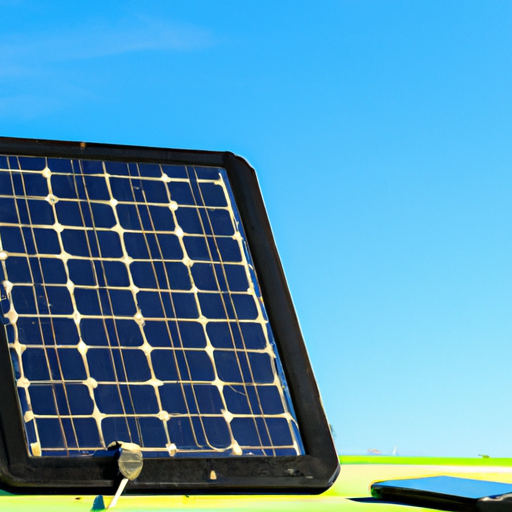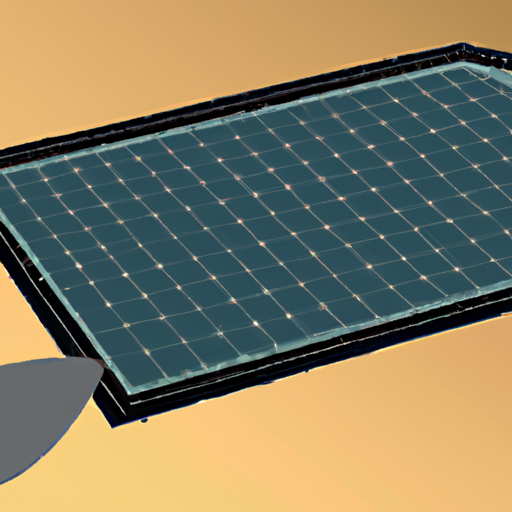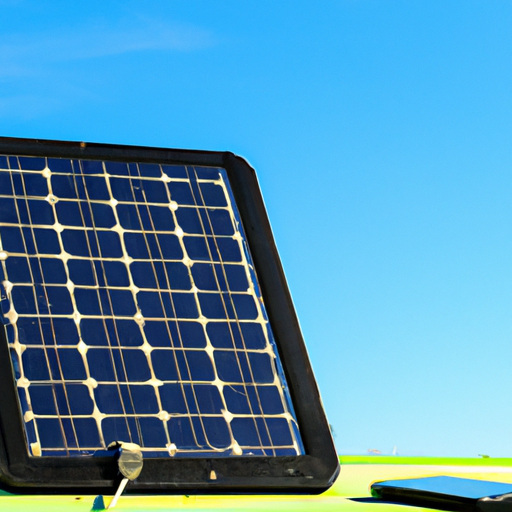

So you’re out on an adventure, maybe camping or hiking, and you want to make sure your electronic devices stay charged. You’ve got your trusty portable solar panel with you, but you’re wondering if you can charge your devices directly from it, without the need for a power bank. Well, the answer is yes, you can! In this article, we’ll dive into the details of how exactly you can do this and what you need to keep in mind. So let’s get started!
When it comes to charging your electronic devices directly from a portable solar panel, there are a few things you need to consider. First and foremost, you’ll need a compatible solar panel that is designed to charge electronic devices. These panels often come with USB ports or other types of connectors that allow you to connect your devices directly. It’s important to check the specifications of the solar panel and ensure that it is capable of providing the necessary output to charge your devices efficiently.
Next, you’ll need to be mindful of the weather conditions. Solar panels rely on sunlight to generate electricity, so if it’s a cloudy or overcast day, the charging efficiency may be significantly reduced. It’s also important to position the solar panel in direct sunlight to maximize its charging capabilities. And finally, keep in mind that charging your devices directly from a portable solar panel may take longer compared to using a power bank. So if you’re in a hurry, it might be best to have a power bank as a backup.
In conclusion, it is possible to charge your electronic devices directly from a portable solar panel without a power bank. However, there are a few factors to consider such as the compatibility of the solar panel, the weather conditions, and the charging efficiency. If you’re prepared and take these factors into account, you can enjoy the convenience of charging your devices using clean and renewable energy while on your outdoor adventures. So go ahead and harness the power of the sun to keep your devices charged up!


Introduction
In today’s world, where electronic devices have become an integral part of our daily lives, the need for efficient and convenient charging solutions is paramount. Portable solar panels have gained popularity as a sustainable and reliable alternative to traditional power sources. But can you charge electronic devices directly from a portable solar panel without the need for a power bank? In this article, we will explore the possibilities and limitations of directly charging your devices using a portable solar panel.
Understanding Portable Solar Panels
What are portable solar panels?
Portable solar panels, also known as photovoltaic panels, are devices that convert sunlight into electrical energy. They are designed to be lightweight and easy to transport, making them ideal for outdoor activities such as camping, hiking, and traveling. These panels are equipped with solar cells, which absorb sunlight and use the photovoltaic effect to generate electricity.
How do portable solar panels work?
Portable solar panels consist of numerous solar cells, often made of silicon, that are connected in series or parallel to create a larger surface area for sunlight absorption. When sunlight strikes these solar cells, the photons in the light excite the electrons in the cells, creating a flow of electricity. This direct current (DC) is then converted to alternating current (AC) using an inverter, making it compatible with our electronic devices.
Advantages of portable solar panels
Portable solar panels offer several advantages over traditional charging methods. Firstly, they provide a sustainable and eco-friendly charging solution by harnessing the power of the sun. This significantly reduces our dependence on fossil fuels and minimizes our carbon footprint. Additionally, portable solar panels are highly versatile and can be used in various outdoor settings where access to electricity may be limited. They also provide a convenient charging option during power outages or emergencies.
Charging Electronic Devices
Compatibility of electronic devices with solar panels
Before attempting to charge your electronic devices using a portable solar panel, it is important to ensure their compatibility. Most modern devices, such as smartphones, tablets, and laptops, can be charged using DC power sources like portable solar panels. However, it is essential to check the device’s specifications to verify its input voltage and current requirements.
Charging devices directly from a portable solar panel
Yes, it is possible to charge electronic devices directly from a portable solar panel without the need for a power bank. By connecting your device’s charging cable to the portable solar panel’s output port, you can transfer the generated electricity directly to your device. However, it is crucial to remember that charging times may vary depending on factors such as sunlight intensity, panel efficiency, and the power requirements of your device.
Factors affecting charging efficiency
Several factors influence the charging efficiency when using a portable solar panel. Firstly, the intensity of sunlight plays a significant role. Charging your devices under direct sunlight will yield better results compared to cloudy or shaded conditions. Panel efficiency is another crucial factor, as higher efficiency panels can convert more sunlight into electricity. Lastly, the power requirements of your device and the amount of sunlight available will determine the charging speed and overall efficiency.


Power Bank vs. Direct Charging
Benefits of using a power bank
Using a power bank alongside your portable solar panel has its advantages. Firstly, a power bank acts as a buffer, allowing you to store excess solar energy and use it to charge your devices later. This is particularly useful when sunlight is not readily available or during nighttime charging. Power banks also provide a stable and regulated power output, which can be beneficial for protecting your devices from voltage fluctuation or surges.
Drawbacks of using a power bank
While power banks offer convenience and stability, they also have some drawbacks. Firstly, they add an additional weight to your outdoor gear, making them less ideal for lightweight travelers or backpackers. Power banks also have a limited capacity, meaning they can only store a certain amount of energy and may need to be recharged regularly. Additionally, power banks require their own charging source, which may not always be available in remote or off-grid locations.
Benefits of direct charging
Directly charging your devices from a portable solar panel without a power bank offers increased convenience and weight reduction. By eliminating the need for an additional device, you can travel lighter and have fewer components to manage. Direct charging also ensures that you are utilizing the full potential of your portable solar panel, as no energy is lost during storage or conversion.
Drawbacks of direct charging
While direct charging has its benefits, there are also some limitations. Charging your devices directly from a portable solar panel may require constant exposure to sunlight, as interruptions in sunlight may interrupt the charging process. Moreover, depending on the power output of your solar panel and the power requirements of your devices, charging times may be longer compared to using a power bank.
Selecting the Right Portable Solar Panel
Wattage and power output
When choosing a portable solar panel, it is essential to consider its wattage and power output. Higher wattage panels will generally generate more electricity, allowing for faster charging times. However, higher wattage panels may also be larger and heavier, which could affect portability. It is important to strike a balance between power output and portability based on your specific charging needs.
Solar panel type and efficiency
There are various types of solar panels available, including monocrystalline, polycrystalline, and thin-film panels. Monocrystalline panels are known for their higher efficiency and smaller size, making them a popular choice for portable applications. Polycrystalline panels are more affordable but slightly less efficient, while thin-film panels are flexible and lightweight but tend to have lower efficiency rates.
Portability and size
Since portable solar panels are designed for outdoor use, their portability and size are crucial considerations. Smaller and lightweight panels are easier to transport and ideal for backpacking or traveling. However, it is essential to find a balance between size and power output, as larger panels may provide more electricity but could be inconvenient to carry.
Additional features
Some portable solar panels come with additional features that can enhance their functionality and convenience. These features may include built-in USB ports for direct device charging, integrated storage pouches for cables and accessories, and collapsible or foldable designs for easy storage. Considering these additional features can ensure a more seamless charging experience.
Maximizing Charging Efficiency
Positioning and angling of the solar panel
Proper positioning and angling of your portable solar panel can significantly impact its charging efficiency. It is recommended to position the panel in direct sunlight without any obstructions, such as trees or buildings, that could cast shadows. Tilting the panel to face the sun directly can optimize sunlight absorption, especially during mornings and evenings when the sun’s angle is lower.
Utilizing sunlight conditions
Sunlight conditions vary throughout the day, with peak intensity usually occurring around noon. It is advisable to take advantage of this peak intensity to charge your devices, as you can maximize charging efficiency during these periods. If sunlight is limited, consider adjusting your charging times accordingly or moving the panel to a sunnier location.
Optimizing device settings
To further enhance charging efficiency, you can optimize the settings on your electronic devices. Lowering the screen brightness, disabling unnecessary background applications, and enabling power-saving modes can reduce power consumption and enable faster charging. However, it is important to balance device functionality and power-saving measures based on your specific needs.
Protection and Safety
Overcharging prevention
When charging your devices directly from a portable solar panel, it is essential to monitor the charging process to prevent overcharging. While most modern devices are equipped with built-in safeguards to prevent overcharging, it is still advisable to disconnect the device once it reaches a full charge. Overcharging can lead to excessive heat generation or damage to the device’s battery.
Voltage regulation
Portable solar panels often come with voltage regulators to ensure a stable and regulated power output. These regulators protect your devices from voltage spikes or surges, which can cause damage. It is important to choose a solar panel with a reliable voltage regulator to ensure the safety of your devices.
Protection against weather conditions
Since portable solar panels are designed for outdoor use, they are often built to withstand various weather conditions. However, it is still crucial to protect your panel from extreme temperatures, moisture, and physical damage. When not in use, storing your panel in a protective case or bag can shield it from potential damage. Additionally, avoid exposing your panel to harsh weather conditions such as heavy rain, snow, or direct sunlight for extended periods.
Storage and Transport
Storing solar panels properly
To ensure the longevity and performance of your portable solar panel, proper storage is essential. When not in use, it is advisable to store the panel in a dry and cool environment to prevent any moisture or temperature damage. Some panels come with protective cases or storage pouches, which can offer added protection during transport or storage.
Transporting solar panels
Transporting a portable solar panel requires some care to avoid damage. Foldable or collapsible panels are often more compact and easier to transport. Additionally, using a protective case or storage bag can offer an extra layer of protection during travel. When packing your solar panel, ensure it is not in direct contact with any sharp objects or heavy items that could potentially damage the panel.
Real-Life Applications
Charging smartphones and tablets
Portable solar panels are compatible with a wide range of electronic devices, including smartphones and tablets. By directly charging your devices from a portable solar panel, you can ensure a sustainable and convenient charging solution, even in outdoor settings or during power outages.
Charging laptops and cameras
Laptops and cameras often require more power compared to smartphones or tablets. While it is possible to charge these devices directly from a portable solar panel, it is advisable to check their power requirements and the solar panel’s power output. In some cases, using a power bank alongside the solar panel may be more efficient for charging these high-power devices.
Charging camping equipment and outdoor devices
Portable solar panels are particularly useful for charging camping equipment and other outdoor devices such as GPS units, lanterns, or portable speakers. These devices often have lower power requirements and can easily be charged directly from a solar panel without the need for a power bank.
Conclusion
In conclusion, it is indeed possible to charge electronic devices directly from a portable solar panel without the need for a power bank. By understanding the compatibility of your devices, optimizing charging efficiency, and ensuring protection and safety measures, you can enjoy the benefits of sustainable and convenient charging wherever you go. Whether you are camping, hiking, or simply exploring the great outdoors, a portable solar panel can provide a reliable power source for all your electronic devices. So, go ahead and embrace the power of the sun to charge your devices directly, and reduce your reliance on traditional energy sources.



